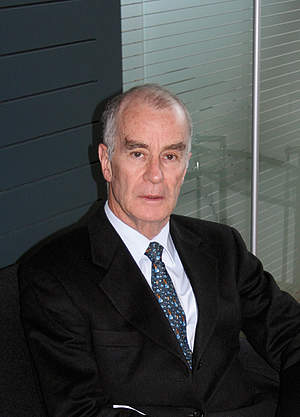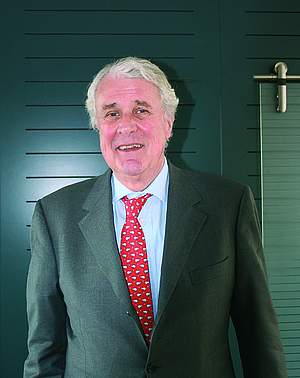Congress Programme Committee
The CPC is responsible for the scientific programme at EFNS organised congresses. It has nine members: its chairperson, the chairperson of the Teaching Course Committee, four other members appointed by the chairperson and three members appointed by the national society of the hosting country. The CPC meets at a certain schedule in the meeting facility of the Headoffice in Vienna. The programme of the relevant congress is being determined 2 year in advance. There are 6 main topics (Cerebrovascular diseases, Dementia, Movement disorders, Epilepsy, Multiple Sclerosis, Headache + Pain) which have to be included in the programme yearly, as well as 3 further main topics in smaller fields of neurology, which do not appear every year.
Chairpersons

Initially, I had some reservations to join the EFNS, since it was succeeding the Paneuropean Society of Neurology which was mainly based in Central Europe and operated by a group of closely related conservative neurologists. The scientific orientation of this group biased the topics discussed at the congresses of the Paneuropean Society of Neurology, e.g. in Vienna 1991, but also was in some aspects carried over to the first Regional Meetings of the EFNS, e.g. in Berlin 1993 and in Prague 1997 and the first full-fledged Congresses of the EFNS, e.g. in Rome 1996, which I attended. With the foundation of the EFNS after the World Congress of Neurology in Vancouver 1993 the orientation of the EFNS changed with the new members of the Management Committee and an orientation towards research based neurology as established in Western Europe and the USA and Canada was accomplished. This strategic decision of the Management Committee under the Presidency of Jes Olesen (10 points of mission) was the basis for the development of programs for the Congresses of the EFNS, and it was a great honour – but also a burden – when Jes Olesen and Uschi Tschabitscher offered me the position of Chairman of the Programme Committee (and at that time also of the Scientific Committee) in 1993 for the following annual congresses. I am very grateful to the international members of the PC that together we developed the guidelines for the programmes of the EFNS congresses, setting the rules for main topics, focussed workshops and oral as well as poster sessions, which in principle are still followed with some alterations, additions and improvements. The first congress organized according to these guidelines in Seville in 1998 attracted 4200 participants – the city certainly was also part of this attraction – and additionally was a big financial success setting the economic foundation for the EFNS for the following years. The structure of the programme was successfully applied to the following congresses in Lisbon 1999, Copenhagen 2000 and Vienna 2002; 2001 the EFNS did not organize its own congress but was partner at the WFN World Congress of Neurology in London with membership in the Programme Committee and organization of a Main Topic Session.

To chair the congress programme committee was for me one of the most exciting jobs as EFNS officer. The committee members were very active and had excellent ideas. Our "team" helped improving significantly the congress programme which led to a historical increase of the number of participants to more than 4000 people. All this made the EFNS organizer of the leading neurological congress in Europe. Also the reputation of our congresses increased in such a way that more than 20% of the participants are now coming from out of Europe.

I became involved in EFNS in the summer of the 1991 (if I remember correctly) when Cesare Fieschi, Head of my Departement at the University Hospital in Rome, asked me to join him for a lunch with Franz Gestenbrand and Uschi Tschabitscher at an autogrill on the highway from Naples to Rome, since they were returning from Capri. Franz, with his usual vigorous attitude, proposed to Cesare to organize the Congress for the new born Federation in Rome. And we did it with Jes Olesen as President, since Franz had just stepped down in 1995.
In the following years I also acted as the Chair of the Neuroimaging Scientific Panel, enjoying the collaboration of important scientists such as Pavel Kalvach, Jean Claude Baron, Daniela Perani, Patrizia Pantano, and José Masdeu, among others. When I left the Chair to JC Baron, I was elected to the Teaching Course Committee, happily working with the Chairman Professor Aarli.
When Cesare Fieschi had to leave the Management Committee, I was called into the Committee as a “member-at-large”, possibly because the members of the EFNC MC wanted to maintain an “Italian” representative on the board, and possibly because they knew that I was familiar with the mechanisms of the EFNS rules and attitudes and most likely, some of them had known me for many years and knew my main rule in life: “why suffer”.
I stayed in the MC and actually partecipated in two of the major achievements/changes that EFNS activated in the late nineties and during the first years of the new millennium. Those changes, the definite neuro-political initiative in Bruxelles that Jes Olesen decided to begin, and the even more important acquisition of the beautiful loft at BreiteGasse in Wien to be used as our main headquarters. I remember, but will not reveal to EFNS posterity, those trembling voices that attempted to block EFNS involvment in such an uncertain financial investment. The happy spenders won and our Archivist, then the EFNS Treasurer was later quite happily involved with Architects, designs, and plans. I also remember very well that a few months later, EFNS was offered a price of double the investment to purchase our new office space.
However, as far as my involvement with EFNS is concerned, the turning point was definitely the EFNS Paris 2004 Congress. My term within the MC expired after four interesting years, and the entrance of Giorgio Cruccu in the MC as Secretary practically blocked the presence of a second italian. Thus I went to Paris taking three of my daughters and my wife and together we definitely attended more museums and shows than I attended scientific sessions. Therefore, on the evening when we were preparing for a nice dinner at Place Pigalle, lobster and fruits-de-mer, and I received a call from the President, Dieter Heiss, asking to see me for a brief private talk, I quickly tied my tie, and hurried downstairs, totally uncertain about the theme of Dieter’s request, let me say slightly worried, because of his serious voice when he called.
My family dinner was a very happy and expensive one as we celebrated the President’s offer of the position as Chairman of the CPC for the years 2006-07 with one of the best french champagnes! And, since I readily accepted, here I am.

The EFNS Congress represents a yearly highlight for European neurologists and European neurology. At the Congresses, 5 - 6 000 participants meet to discuss how to improve treatment and diagnosis for patients with disorders in the brain and the nervous system, and how to prevent such diseases. New research results have a major focus. The fixed program with the main sessions, focused workshops and teaching courses represent the backbone structure. Free presentations as short oral lectures and posters are core activities, and satellite symposia, special sessions and the exhibition broaden our knowledge base. For the participants, the active contact and exchange of views with colleagues from other countries and with other experiences is nearly as important as the scientific program. It is a privilege to take active part in shaping the EFNS Congress. First as the head of the EFNS scientific committee and later as the leader of the Congress Programme Committee, it has been great fun to select and plan the program, and even more so to enjoy the Congress itself. The number of excellent program suggestions within all topics is impressive. The EFNS Scientist panels have been the main source for these suggestions. Even with several parallel sections we could have filled many more days with a highly interesting program. Also the numbers of submitted abstracts have been high and increasing, but we will always aim for more abstracts, and especially for more abstract of the highest scientific quality. In recent years, both the number of abstracts and participants from outside Europe has increased markedly, especially from countries such as Iran, South Korea and China. Recent developments of the program have been the highlight session at the end, the presentation of recent EFNS guidelines, and a session on therapy controversies; pros and cons. Technology is moving fast, and e-posters and video sessions are integral elements of the Congress. This development continues, but as the most important aspect for the participants is to meet, congresses in neurology will prosper and increase in popularity, e-transfer of new information is not sufficient alone. The joint EFNS and ENS Congress in 2014 and the first EAN Congress in 2015 will without doubt be resounding successes, building on the experience and sound organization of the EFNS, and also of the ENS Congresses through more than 20 years. The aim should be to bring together all fields of neurology at the EAN Congress, so that this will be the place to present the major achievements for disorders in the brain and the nervous system. The European congress should be what no neurologist would like to miss, representing the obligatory yearly update.